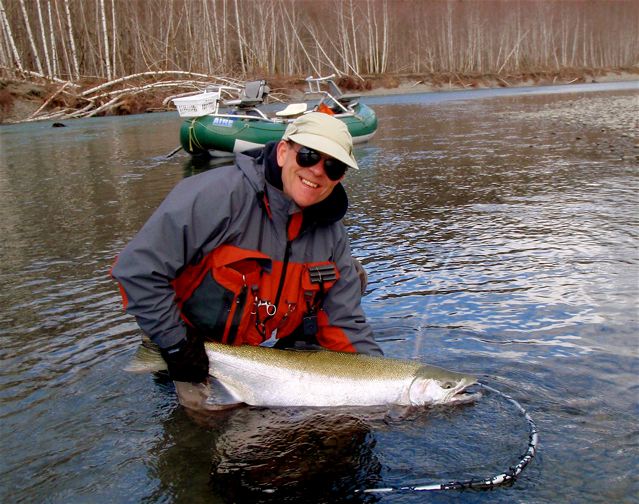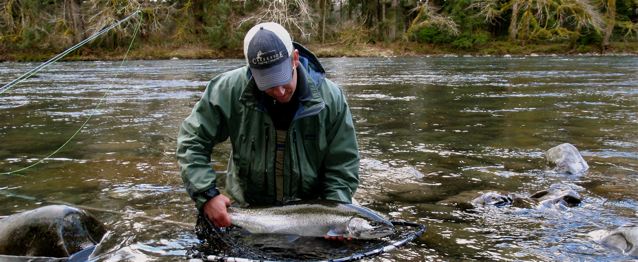Tools of presentation
In an effort to write just a little bit about presentation I have deleted almost more words than I have written.
Fly-fishing, for most of us is made up of, books,conversations, rods, new wading jackets, long car rides and pictures of places we can’t afford to go.
We want tighter loops, higher floating lines and wading shoes that will keep our hats dry.
Not to mention, sun dappled streams, dusty roads, cold beer and the smell of Bar-b-que at the end of the day.
Oh, and fish.
Presentation is about what the fish want.
I am going to try to write a few entries about the things that happen at the far end of the leader.
Seeing Beyond the Indicator
Indicate Sign, suggestion, symptom, a signal, hint, warning, clue, pointing to something,something exists or is true
When discussing steelhead nymphing the first thing most people visualize is a bobber.
A lot of people stop looking right there.
When I learned about nymphing, I learned about a very different thing.
When I was a kid what most people I knew meant by nymphing was a nymph, or any sub surface fly, fished on a dead drift.
Because we added no weight or strike indicator you had to fish a very short line to get a good drift. Fishing close also helped you detect bites because often all you had to go on was the most subtle pause in the leader.
That definition has remained true to me until this day, any sub-surface dead drift presentation is “nymphing”.
The indicator may or may not show a bite, what it will do is let you know where your fly is; is it ahead, behind, to the right or left of the indicator? It will tell you if your line is dragging your fly or if your fly is pulling your line. This information hints at what the currents are doing beneath the surface, its like a X-ray of the river, but you have to learn to read it.
Even for die hard spey casters, a little nymphing, from time to time, can help blow off steam
Like wise the primary purpose of the weight is not to make the fly sink. Yep weight makes stuff sink faster, but more importantly it creates a place on the leader to anchor the mend.
A lot of people assume nymphing is about fishing deep, on the Peninsula, even in the coldest water this is rarely the case. The purpose of the nymph rig, no matter how it’s designed is to fish the fly with a controlled dead drift. Adding a ton of weight makes controlling the rig harder, and destroys the indicators (if your using one) ability to tell you all its secrets.
Winter fish hold in all kinds of water, my goal in putting together a winter rig is versatility. I want one set up that will allow me to fish any water, fast of slow, between1 and 5 feet deep.
The fish come in chrome bright, are easy to spot, and not at all shy. They will let you walk right up and cast at them, but they are dead set on having the fly just the way they want. On a daily basis we will anchor next to a fish and begin casting, often the fly will pass within a foot of the fish more than a dozen times with no reaction what so ever.
And then, the perfect cast, and you can call it, he’s gonna‘ eat THAT ONE!
The lesson to be learned is all the preceding casts looked pretty good, but often only perfect will do.
Spey casters walk by it, drift boats row over it, what is it? The best nymph water on the Peninsula.
Obviously “perfect” presentations come from practice and experience, but there is another element that I think is every bit as important. Take your time and think the whole presentation through before you make the cast. Remember, goal one is to get the right drift, not to land the fish, that’s a bunch of steps ahead.
Preparing to make a good cast and thinking through your drift becomes automatic over time, but its one of those great basic lessons that’s always worth re-visiting.
Nymphing for steelhead is not about a specific rig or fly,it’s about a style of presentation. Presentation is about awareness and control.
Remember, don’t let the leader, the line or the strike indicator move the fly. Only the river moves the fly. You control the line,indicator, leader, and weight so that they move with the river, allow the
river to move the fly.
One of the great things about steelheading is that sooner or later all presentations meld into one. A cast that starts with a dead drift becomes a swing and ends up being stripped. Each aspect will produce fish over time if you think it through.
Jim Kerr
Raincoast guides





That was a great all around article, and I especially liked the part about visualizing what you’re going to do before you do it. Pertinent to so many things in life, not excluding nymphing!
Amen Brotha, I couldn’t have said it better myself. When I win the lottery YOU will be my private fish Guru as I will pay you a handsome salary !!!!
Out of curiousity, how do you set yp your nymph and indicator rig? For example, do you use a tapered leader or a straight piece of mono from the fly line to the fly? Thanks!
I usually build my own tapered leader with a lighter than average but section. This helps prevent the leader from billowing out behind the cater, but still aids in casting. Kinda depends though, if I am wading and only carrying one rod I might use a standard taper for easy change ups to other systems.
Jim